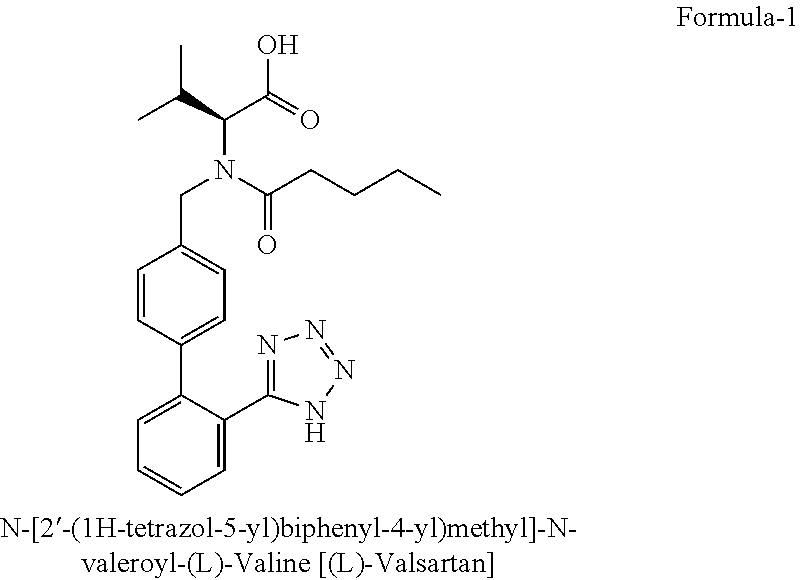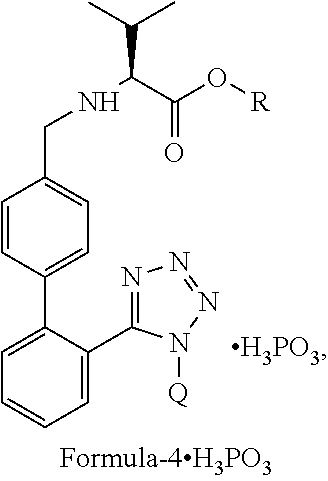Process for the preparation of angiotensin ii antagonists and intermediates thereof
- Summary
- Abstract
- Description
- Claims
- Application Information
AI Technical Summary
Benefits of technology
Problems solved by technology
Method used
Image
Examples
example 1
Stage-1—Preparation of N-[2′-1-triphenylmethyl-tetrazol-5-yl)biphenyl-4-yl)methyl]-(L)-valine benzyl ester.H3PO3 salt
[0098]104.6 g L-Valine benzyl ester hydrochloride was dissolved in DM-water and basified with 20% sodium hydroxide solution to pH of about 10-12. Ethyl acetate was added and stirred for 20 min and the ethyl acetate layer was separated. To the ethyl acetate layer was added TTBB and stirred for 12-14 hrs at 55-60° C. The Ethyl acetate layer was washed with DM water.
[0099]The aqueous layer was preserved for the recovery of L-Valine benzyl ester. Phosphorous acid (23.2 g) was added to the ethyl acetate layer under stirring and stirred for 1.0 hr
[0100]The solids were filtered and stirred in DM-water for 30 min, filtered, suck dried well and dried in vacuum over at 55-60° C. till moisture content was NMT 2.0%
[0101]Weight: 125-130 g % Purity (by HPLC): 97.0%(+) Yield: 91-95%
example 2
Stage-2—Preparation of N-[2′-1-triphenylmethyl-tetrazol-5-yl)biphenyl-4-yl)methyl]-N-valeroyl-(L)-valine benzyl ester
[0102]Stage-I phosphite salt (100 g) from example 1 above was dissolved in DM-water (500 ml) and the pH of aqueous layer adjusted to 7-8 and extracted with dichloromethane (250×2)
[0103]To the extracted dichloromethane was added Diisopropyl ethyl amine (25.3 g) under stirring at −5 to −10° C. After addition, the reaction mixture was stirred for 30 min at −5 to −10° C. N-Valeroyl chloride (24.2 g by diluting with 200 ml dichloromethane) was added slowly under stirring for 1-2 hrs maintaining pot temperature between −5 to −10° C. After addition, the reaction mixture was stirred for 2-3 hrs and monitored for completion by HPLC. The reaction mass washed with 5% NaHCO3 solution, 5% HCl solution and followed by 5% NaHCO3 solution and finally the solvent was stripped under vacuum to provide the title stage-2 intermediate.
[0104]Weight: 115-120 g % Purity: 97.0%
example 3
Stage-3—Preparation of (L)-Valsartan
[0105]Stage-II (100 g) was dissolved in 1.0 lt methanol and charged into the autoclave About 2-3 ml DIPEA (Diisopropyl ethyl amine) was added, then 10 g 10% Pd / C (50% wet) and pressure of 3-5 kg / cm2 maintained for 6.0 hrs and the reaction mixture monitored by HPLC. The side product was isolated by filtration, the filtrate was concentrated completely and dissolved in 5% caustic solution, washed with Toluene (300 ml×3), acidified with 5% HCl solution and pH adjusted to 2-3. The solids were extracted with EtOAc (150 ml×2), the solvent stripped completely.
[0106]Weight: 100-110 g % Purity (by HPLC): 97.0% (+)
PUM
 Login to View More
Login to View More Abstract
Description
Claims
Application Information
 Login to View More
Login to View More - R&D
- Intellectual Property
- Life Sciences
- Materials
- Tech Scout
- Unparalleled Data Quality
- Higher Quality Content
- 60% Fewer Hallucinations
Browse by: Latest US Patents, China's latest patents, Technical Efficacy Thesaurus, Application Domain, Technology Topic, Popular Technical Reports.
© 2025 PatSnap. All rights reserved.Legal|Privacy policy|Modern Slavery Act Transparency Statement|Sitemap|About US| Contact US: help@patsnap.com



